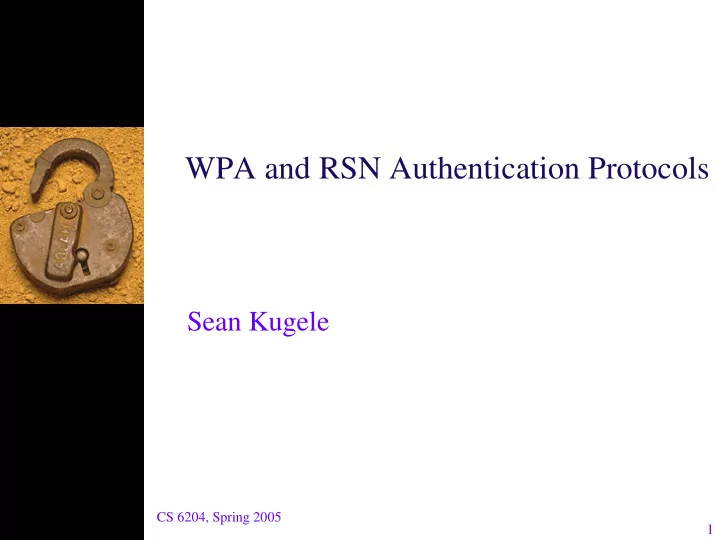

WPA and RSN Authentication Protocols Sean Kugele CS 6204, Spring 2005 1
Motivation ♦ Weaknesses in the WEP protocol 1. No protection against message tampering 2. Incorrect usage of an encryption algorithm 3. Replayable authentication method ♦ Proposed Solutions • WPA (Wifi Alliance) • RSN / WPA2 (802.11i) CS 6204, Spring 2005 2
WPA and RSN ♦ Separate the user authentication and message protection process • Allows for dynamic key management • Allows existing authentication protocols used in wired environments to be adapted for use in WLANs ♦ Adopted the 802.1x authentication model • Three entities (Client, AS, NAS) ♦ EAP used to communicate during authentication process CS 6204, Spring 2005 3
4 802.1x model CS 6204, Spring 2005
Extensible Authentication Protocol (EAP) ♦ Used to encapsulate other authentication protocols ♦ Four Message Types • Request • Response • Success • Failure CS 6204, Spring 2005 5
6 EAP Message Flow CS 6204, Spring 2005
Paper’s Goal ♦ Define the characteristics of a “good” authentication protocol ♦ Survey the existing authentication protocols and determine how well they satisfy these characteristics CS 6204, Spring 2005 7
Desired Properties of WLAN Authentication Mutual Authentication 1. Identity Privacy 2. Dictionary Attack Resistance 3. Replay Attack Resistance 4. Derivation of Strong Session Keys 5. Tested Implementation 6. Delegation 7. Fast Reconnect 8. CS 6204, Spring 2005 8
Three Categories for Proposed Protocols ♦ Secret Key Methods ♦ Public Key Methods ♦ Tunneled Methods CS 6204, Spring 2005 9
Secret Key Methods ♦ The client and AS have a shared secret and establish a trust relationship by proving mutual knowledge of that secret Pros: Efficiency, require little computational power Cons: Difficult to prevent dictionary attacks without introducing computational overhead CS 6204, Spring 2005 10
Secret Key Methods Lightweight Extensible Authentication Protocol 1. (LEAP) Kerberos v5 2. EAP-Secure Remote Password (EAP-SRP) 3. CS 6204, Spring 2005 11
Lightweight Extensible Authentication Protocol (LEAP) CS 6204, Spring 2005 12
13 Kerberos v5 CS 6204, Spring 2005
EAP-Secure Remote Password (EAP-SRP) CS 6204, Spring 2005 14
Public Key Methods ♦ Public/Private key pair used for authentication. Certificates are generally used to establish trust Pros: Solves dictionary attack vulnerability Cons: More complicated to deploy than secret key methods CS 6204, Spring 2005 15
Public Key Methods EAP-TLS 1. ID-Based Cryptography 2. Greenpass 3. CS 6204, Spring 2005 16
EAP-Transport Layer Security (EAP-TLS) CS 6204, Spring 2005 17
ID-based Cryptography CS 6204, Spring 2005 18
19 Greenpass CS 6204, Spring 2005
Tunneled Methods ♦ Authentication divided into two phases: 1. The client authenticates the AS using EAP-TLS. The resulting session key is used to establish an encrypted tunnel for further communications 2. The AS authenticates the client through the encrypted tunnel. – Allows the use of a less secure legacy protocol for client authentication Pros: 1. Tunnel hides client’s identity by encrypting the contents of the EAP Response-Identity message 2. Provides resistance to dictionary attacks and replay attacks, even if the protocol used for client authentication does not Cons: 1. Vulnerable to a Man-in-the-Middle Attack CS 6204, Spring 2005 20
Tunneled Methods Protected EAP (PEAP) 1. EAP-Tunneled TLS (EAP-TTLS) 2. CS 6204, Spring 2005 21
PEAP vs. EAP-TTLS ♦ These methods differ only in the supported methods for client authentication – PEAP supports all EAP methods – EAP-TTLS supports legacy password protocols, such as LEAP, in addition to all EAP methods. CS 6204, Spring 2005 22
23 Protocol Comparison CS 6204, Spring 2005
Conclusions ♦ LEAP and Kerberos not sufficiently secure due to dictionary attack vulnerability ♦ EAP-SRP and ID-based Cryptography lack current implementations for WLANs, so they may contain unknown vulnerabilities ♦ EAP-TLS provides strong security, but lacks support for delegation or identity privacy ♦ Greenpass, Eap-TTLS, and PEAP are the most promising because they combine EAP-TLS with possible support for delegation and identity privacy CS 6204, Spring 2005 24
Recommend
More recommend